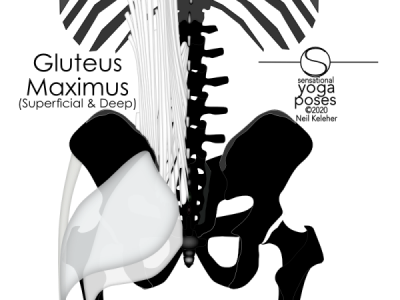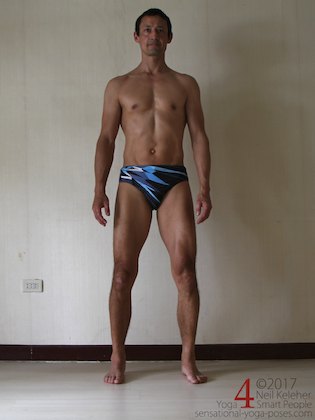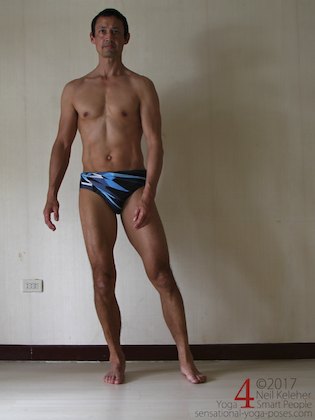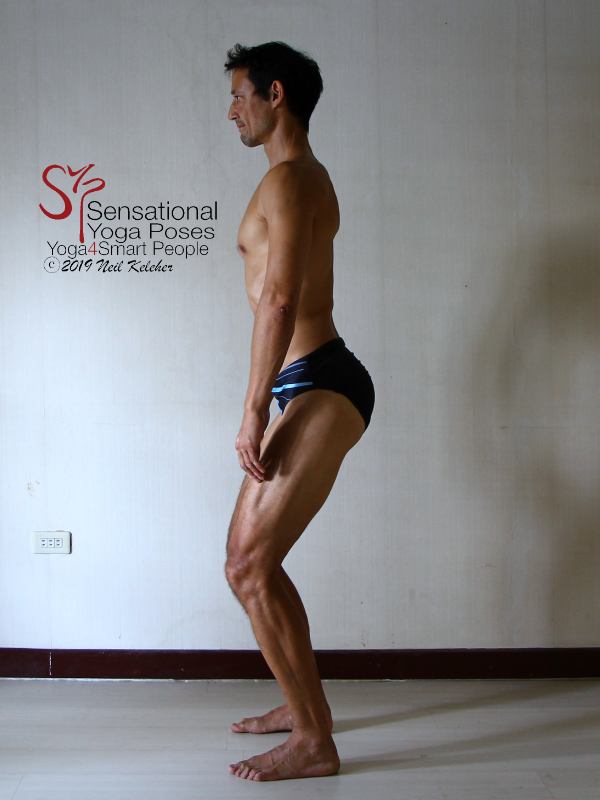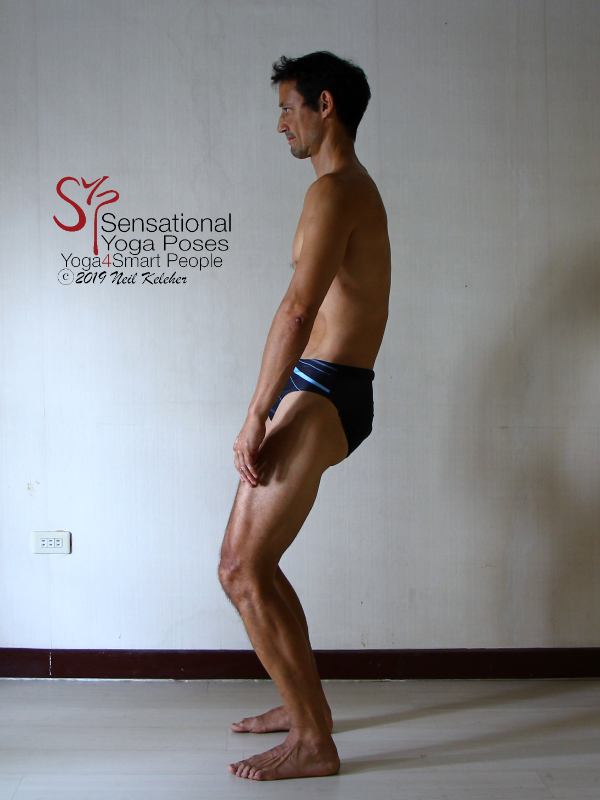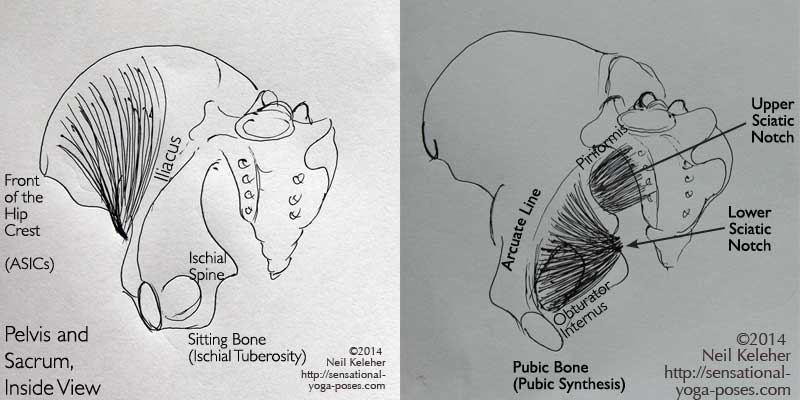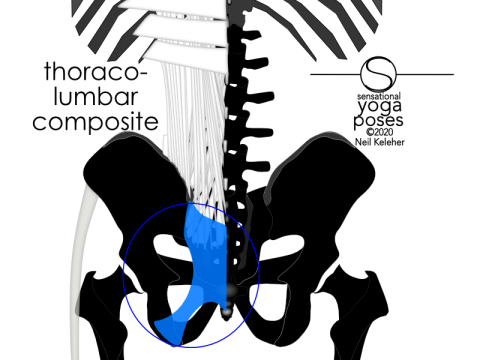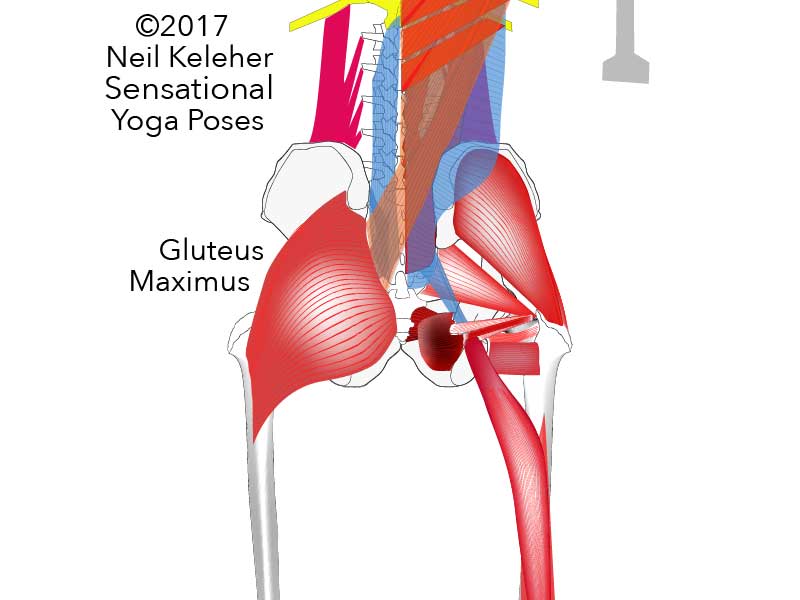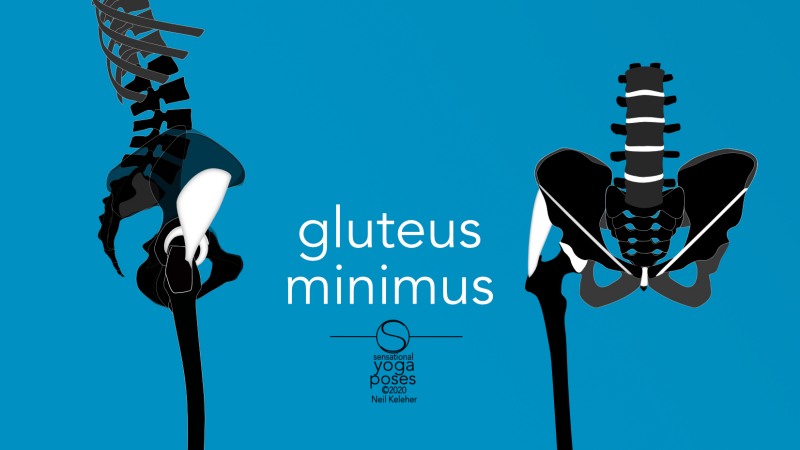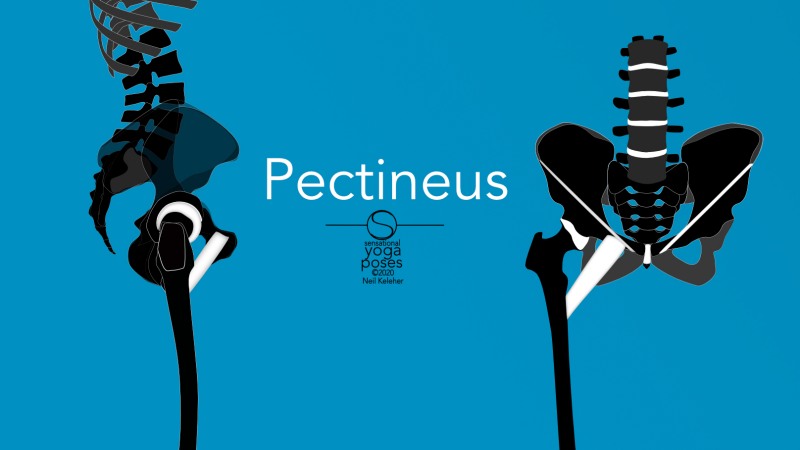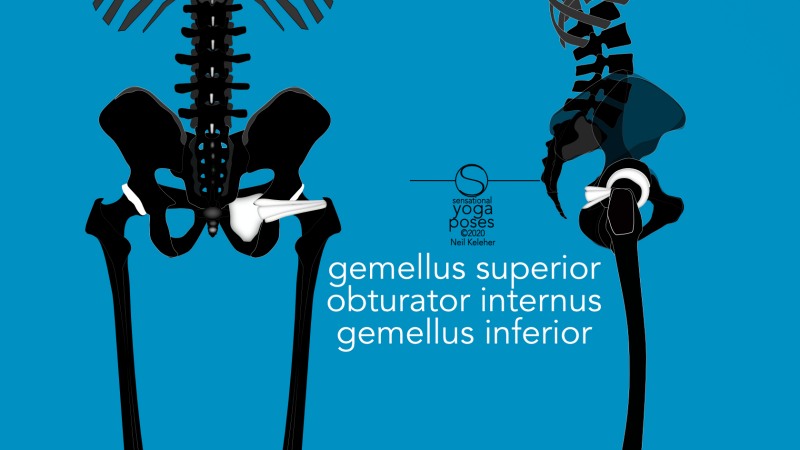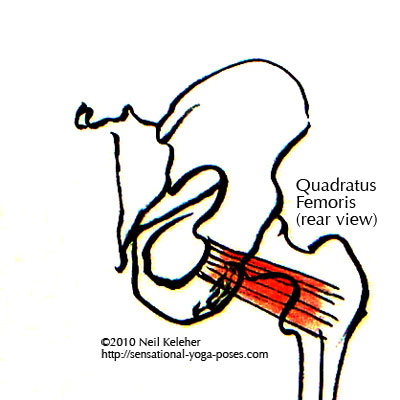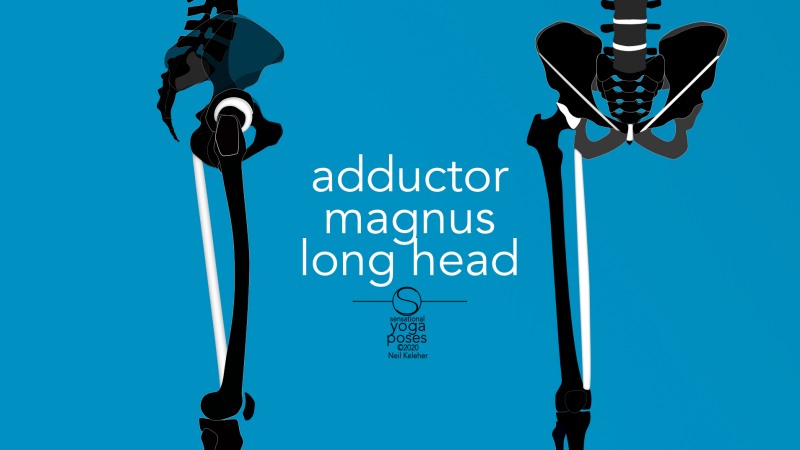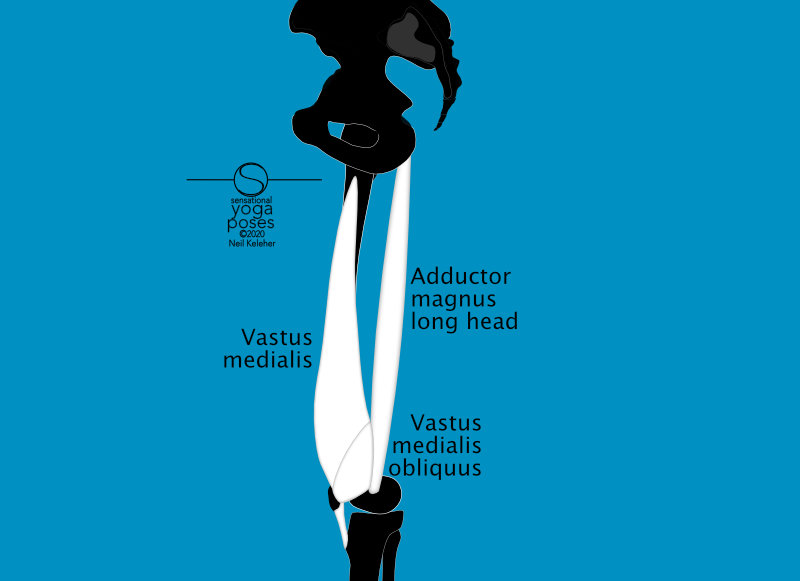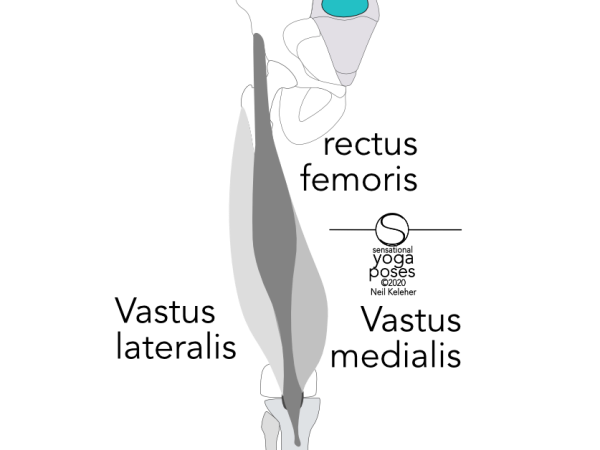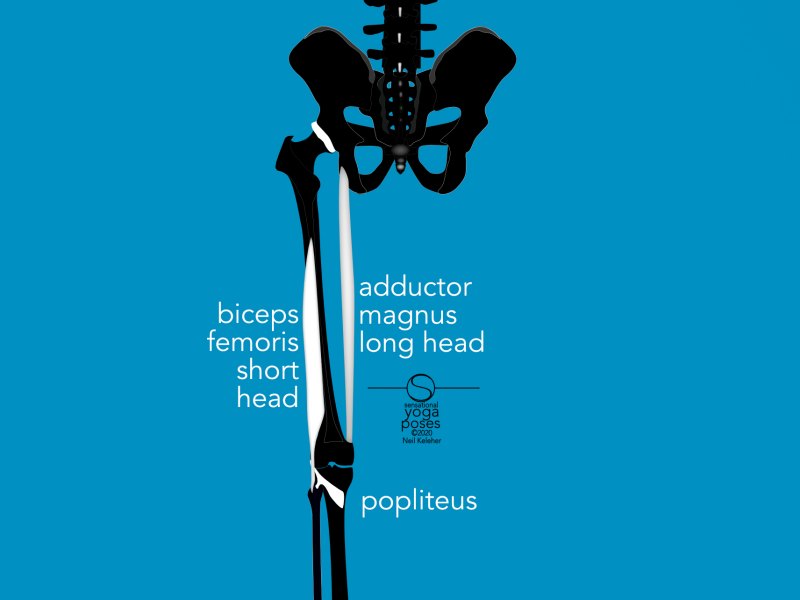Overview of Gluteus maximus functions
The Gluteus maximus is a large muscle. It forms the bulk of the buttocks. It is also a complex muscle with multiple functions.
Stabilizing the SI-joint directly
It may have fibers that help close or stabilize the SI-joint directly. These fibers, attach between the sacrum and the ilium and act solely on the SI-joint. Even without these fibers, the Gluteus maximus can have a strong affect on the SI-joint. And in turn it can be affected by the positioning of SI-joint.
Controlling knee rotation and hip-bone positioning
The "Superficial fibers" of the Gluteus maximus attach from the top back corner of the hip-bone, the PSIC. These fibers run forwards and downwards from the PSIC to attach to the back edge of the IT-band which in turn attaches to the top of the tibia (with a few strands also attaching to the top of the fibula).
This portion of the Gluteus maximus is part of a group of muscles that help control knee rotation. This group of muscles, the long hip muscles, each attach to a corner-point of the hip-bone. Thus they can also control hip-bone positioning.
Controlling hip extension, external rotation and abduction
Then there are the fibers of the Gluteus maximus that attach directly to the femur.
These fibers may attach from the hip-bone, the sacrotuberous ligament, and from the sacrum.
These fibers can extend the hip joint (or resist flexion). They can also externally rotate the hip joint (or resist internal rotation.) Some fibers can also help abduct the hip joint, creating an outward pull on the femur. (These same fibers can also resist adduction, an inward pull on the femur.)
The Gluteus maximus is a complex muscle
It can be easy to think of the gluteus maximus as a simple muscle. i.e. it extends the hip. It externally rotates the hip.
Going deeper and working to understand the different functions of the different parts of the Gluteus maximus can be useful when fault-finding the Gluteus maximus.
For example, the deeper fibers may be functioning, but not the superficial fibers. We can then look at reasons why the superficial fibers aren't firing. It may then be easier to get them to fire based on some simple muscle-control principles.
Some basic principles for fault-finding muscle control problems
When fault-finding any muscle, it helps to understand some basic principles of muscle control. These include:
- Muscles require an anchored end point
- Muscles require optimal operating length (or "span"), i.e. not too tight not not too slack
- Muscles require an opposing force to work against
Using the superficial Gluteus maximus as an example, if it isn't firing:
We can look at anchoring either the PSIC, perhaps generating an upwards pull on it, or anchoring the tibia, by anchoring it against external rotation.
We can look at giving it sufficient operating length. If the knee and hip are both bent, the IT band may be slack. A way to take out the slack is to activate the lateral vastus muscle (over which the IT-band passes).
We can also look at making sure that is has an opposing force to work against. If body weight doesn't provide that force, we can look at opposing muscles like the internal hip rotators, the internal shin rotators, the hip adductors etc.
Standing reference positions
When talking about using the body, particularly when we ourselves are the subject, its helpful to have a reference position that isn't the anatomical reference position.
And so, unless otherwise specified, most of the following discussion assumes an upright standing position with weight on both legs or on one leg. In some cases we may also look at upright locomotion. And in some cases we'll also look at sitting upright.
Some options for anchoring the gluteus maximus
Because the Gluteus maximus attaches at its' lower ends to the top of the tibia and the top of the femur and at its' upper ends to the hip-bone and the sacrum, we can anchor the Gluteus maximus in a number of ways while standing.
We could stabilize the lower legs and femur to anchor the bottom ends of the Gluteus maximus. We can then think of the Gluteus maximus as working on the hip-bone and or sacrum.
Or we can stabilize the hip-bone and/or sacrum and so then think of the Gluteus maximus as working on the femur and lower leg bones.
In either case, it can help to understand whether the SI-joints are nutated, counter-nutated or balanced somewhere in-between.
As a very quick primer, sacral nutation is a nodding or tipping forwards of the sacrum with respect to the hip bones.
Counter-nutation is a nodding or tipping rearwards or the sacrum relative to the hip bones.
In either case, the movement tends to be slight, but is perceivable (or "proprioceivable") and controllable.
Positioning the upper body for sacral nutation
If the pelvis is tilted forwards with the ribcage sliding forwards relative to the pelvis to accomodate this movement, the center of gravity of the upper body tends to shift to a point in front of the sacrum.
While the center of gravity of the upper body is positioned somewhere in front of the sacrum, the center of gravity of the whole body can be kept even between forefeet and heels so that forefeet and heels press down with even pressure. If this is the case then as the ribcage slides forwards, the hips will move rearwards so that the center of gravity of the whole body is kept over the mid-point (between heels and forefeet) of the feet.
Defining sacral nutation
Nutation could be thought of as a nodding forwards of the sacrum relative to the hip-bones. This causes the tailbone, at the bottom tip of the sacrum, to move rearwards relative to the hip-bones while the top of the sacrum tips forwards. At the same time, it causes the hip-bones to hinge so that the sitting bones move outwards.
With the ribcage transitioned forwards as the pelvis is tilted forwards, the weight of the upper body presses down on the top of the sacrum via the lumbar spine in such a way that it helps to drive the nodding forwards of the sacrum relative to the hip-bones.
The hip-bones will follow this movement, but they will lag slightly, so that while the pelvis as a whole tilts forwards, the sacrum tilts forwards more than the hip-bones.
The actual difference in movement between the sacrum and hip-bones will be small, but it will cause the sitting bones to move outwards while the ASICs move inwards.
These movements all occur because of the shape and structure of the SI-joints.
Note that the ASICs and sitting bones (or "ischial tuberosities") are "corner-points" of the hip-bone.
Two other corner-points are the pubic bone (pubic synthesis) and the PSICs.
ASIC stands for Anterior Superior Iliac Crest.
PSIC stands for Posterior Superior Iliac Crest.
How sacral nutation helps to anchor the gluteus maximus
Tilting the pelvis forwards while at the same time transitioning the ribcage forwards can accentuate the arch or back-bend of the lumbar spine. And so this action may be accompanied by activation of the lumbar spinal erectors.
This action also lengthens the fibers of the Gluteus maximus.
This can be handy if you plan on extending one or both hip joints.
The forward tilting of the pelvis helps to anchor the upper end points of the Gluteus maximus. The activation of the spinal erectors further helps in this anchoring effect. In addition, since the fibers of the gluteus maximus are lengthened, it can activate effectively.
With weight on both legs and the pelvis tilted as described above, the Gluteus maximus can activate to help control forward tilt of the pelvis and to help support the weight of the body.
Also note that sacral nutation tends to add tension to the sacrotuberous ligament. And so this helps to anchor the fibers of the Gluteus maximus that attach to that ligament.
Sacrotuberous ligament tension also helps to prevent "SI-joint" sheer.
If standing on one leg, this position of the pelvis, with sacrum nutated, lumbar spine extended and spinal erectors activated, can be helpful for extending the lifted leg.
A quick review of sacral nutation
While it is very possible to nutate the sacrum simply by positioning the pelvis and ribcage as described above, it may be desirous on occasion to make sacral nutation a more active affair.
But first lets quickly review what happens when we do nutation as described above.
In the above case, we can use the weight of the upper body to drive nutation. As a result, the hip-bone and sacrum are tilted forwards by body weight. The sacrum and back of the hip-bones move upwards (the front of the hip-bones move downwards) and this can be used to activate the Gluteus maximus which can then apply force on the femurs and lower leg bones.
Playing with sacral nutation while sitting
While I did say at the beginning that this article would focus on standing upright, these actions of the ribcage, pelvis and sacrum can also be played with while sitting, as I am doing while I write this. And so while sitting, you could, if you chose, translate your ribcage forwards (away from the back of your chair).
Lets assume you aren't resting too much of your body weight on your desk via your forearms or elbows!
As your ribcage slides forwards you can tilte your pelvis forwards. If your arms aren't bearing your body weight, then you can use the weight of your upper body to help tilt your sacrum, and pelvis, forwards.
The more you slide your ribcage forwards, while keeping it upright, you may find the more your lumbar spinal erectors will activate. If you chose, you could try activating your Gluteus maximus on both sides. What you may then get is a sensation of your sitting bones separating and even lifting.
Note it may also feel as if you are increasing the forward tilt of your pelvis as you do this. However, for myself at least, this is a result of the Gluteus maximus activating and generating sensation where previously there was none.
Note that while doing this, smaller muscles will be activating to drive the movement of your pelvis and ribcage. These muscles can be harder to feel or proprioceive.
Making sacral nutation more active
There is a way to make sacral nutation more active. And this assumes that the femurs are stable. In particular it assumes that the femurs are stabilized against external rotation. And it may also assume that the femurs are rotated inwards in order to give the necessary "operating length" to the muscles in question.
Which muscles? The obturator internus.
Using obturator internus and the gemellus muscles
This muscle, along with the gemullus superior and inferior can act from an anchored femur to generate an outwards pull on the sitting bones. What then happens is that sacral nutation is generated by moving the hip-bones relative to the sacrum.
It helps if we move the ribcage forwards at the same time.
So we could potentially still using body weight to drive nutation of the sacrum. However, we can accentuate this by also acting on the hip-bones.
Generating greater hip stability
Something to consider when using the obturator internus, as well as the gemelli muscles, is that these muscles generate a forward push on the hip-bone relative to the femur. And so other muscles need to activate to counter-balance this forward push. Those other muscles can include the pectineus and/or the obturator externus.
Active nutation and adding tension to the sacrotuberous ligament
As mentioned previously, nutating the sacrum tends to cause the sitting bones to move outwards and this in turn helps to add tension to the sacrotuberous ligament. Activating the obturator internus and gemellus is another way of nutating the sacrum. And it is also another way of adding tension to the sacrotuberous ligament. As a result, this type of "active" nutation can make it more likely for the Gluteus maximus to activate.
Centering the hip joint
When standing, the legs are bearing the weight of the body. When only one leg is bearing that body weight, the hip joint of the working leg (as well as the knee and ankle) are bearing double the weight. The force a single hip joint experiences is even greater during the impact experienced while running.
Something to consider is that when upright, the top of the hip socket will tend to sink down onto the ball of the femur. Muscles that can counter act this include the obturators and the gemelli.
When active, as well as helping to nutate the sacrum, these muscles also generate a slight amount of lift on the hip-bone relative to the femur. This lift helps to center the hip joint as a whole.
And so active nutation, with the obturators active, may be helpful for keeping the hip joint centered, particularly when shifting weight more towards one leg or where both legs are bearing more weight than usual, say while holding onto or bearing extra weight.
It bears mentioning that while sitting or in other positions where the hip joints arent' bearing weight, obturator activation can move the hip socket too far in the direction of push. And so when trying to use these muscles in non-weight bearing positions, it can help to resist the action of the obturators by generating an opposing pull between the hip-bone and femur.
By working against each other these muscles help to center the hip joint and keep it centered.
As an example, if sitting in staff pose, you could either push your legs forwards, away from your hip-bones, or push your hip-bones back, away from your femurs. In either case the idea is to activate the obturators.
To counterbalance the obturators, you can then, at the same time, pull back on the leg bones, or forwards on the hip-bones.
Put another way, you are trying to push your thigh bones forwards and pull them back at the same time. A hint that you are doing this correctly is that your Gluteus maximus will activate. Your thighs will also activate.
Why bother with these actions? To stabilize the hip joints even as you keep them centered. And to keep the hip joints lubricated even when dealing with greater loads.
Positioning the upper body for sacral counter-nutation
If the pelvis is tilted rearwards, and the ribcage slides rearwards to accomodate, then the lower back can flatten. If in addition we also slide the head back (or keep it over the ribcage as it slides back) this can shift the center of gravity of the upper body rearwards.
This can be a bit difficult with knees straight and so an alternative is to do it with knees slightly bent.
In this position, the weight of the upper-body via the lumbar spine helps to push the sacrum into counter-nutation.
In other words, the weight of the body helps to tilt the sacrum rearwards.
In counter-nutation, the sacrum tilts rearwards relative to the hip-bones. As a result, the tailbone moves forwards relative to the hip-bones. The top of the sacrum moves rearwards.
And in turn, the hip-bones hinge so that the sitting bones move inwards.
The ASICs then move outwards.
Note that the pelvis as a whole is tilted back in this position. But, the driving force for tilting the pelvis back can come from the weight of the upper body pressing down on the top of the sacrum.
You could use the Gluteus maximus to actively tilt the pelvis rearwards. But, you could also hold this position with the Gluteus maximus relaxed.
In the same vein, you could use your hip flexors (for example, the iliacus) to actively tilt your pelvis forwards during nutation of the sacrum.
To support the weight of the body, the abs can activate in this position. In addition, the psoas may also activate.
Using the Gluteus maximus to counter-nutate the sacrum
You can choose to activate the Gluteus maximus to tilt the pelvis back. You could move your ribcage back as you do so. In this instance, the bulk of the Gluteus maximus can help to "force-close" the SI-joints by pressing inwards on the sitting bones. By pressing the sitting bones inwards, the Gluteus maximus then also counter-nutates the sacrum
Standing on one leg in this position, it can be easier to flex the lifted leg hip.
Side-effects of counter-nutation on the hip and knee joint.
Whether or not the Gluteus maximus is used to create counter-nutation, one of the side-effects of counter-nutation is that as the sitting bones move inwards, the ASICs will move outwards.
This outward movement of the ASICs can act as an anchor for the Sartorius which attaches to the ASIC and from there runs down the inner thigh to attach to the inside of the tibia.
The sartorius can generate an inwards pull on the ASICs. We thus anchor this end of the sartorius by generating an opposing pull. Sacral counter-nutation is one means of generating this counter-pull.
While the leg in question is bearing body weight, the sartorius can act to create an external rotation force on the the thigh relative to the hip-bone while also creating an internal rotation force on the tibia. In addition, it can act to create a flexing force at the hip joint.
Where the sartorius can generate an internally rotating force on the tibia, the superficial fibers of the gluteus maximus can generate an externally rotating force on the tibia. And where the sartorius will tend to flex the hip joint (assuming the shin is stabilized), the gluteus maximus will tend to extend the hip joint.
Thus, in static positions, or during slow, non-ballistic movements, these muscles can work together to control shin rotation and hip flexion/extension.
There are similar side-effects that can result from nutation.
Positioning the upper body for neutral SI-joint positioning
When considering the pelvis and SI-joints, a third option is to position the upper body so that the the weight of the upper body is balanced over the sacrum.
In this position the SI-joints are midway between nutation and counter-nutation. In this position the ribcage, and mass of the upper body, is balanced over the sacrum so that it neither tilts forwards nor backwards.
Where tilting the pelvis forwards and nutating the sacrum can tend to favor hip extension, and tilting the pelvis rearwards and counter-nutating the sacrum can tend to favor hip flexion, the middle position, with the sacrum neutral could allow either movement.
Other options for nutation and counter-nutation include nutating the sacrum at one SI-joint while counter-nutating it at the other SI-joint.
If the sacrum remained relatively stationary, this could be thought of as one hip bone tilting or tipping forwards relative to the sacrum while the other hip bone tilted or tipped rearwards.
It could also be thought of as the ASICs of both hip bones moving to one side, say the right, while the sitting bones of both hip bones moved to the opposite side, to the left.
Walking or running with a nutated sacrum
What might be the advantages of walking (or jogging or running) with the sacrum mainly nutated? One possibility is that you can focus more on hip extension.
For the landing or striking phase (foot contact after swinging the leg forwards), you may find that this position tends to encourage a forefoot landing. Or, you may find that forefoot landing is easier to achieve with this type of sacral positioning.
If you land on the forefoot, with the center of gravity of your body over the forefoot, then the mechanics are relatively simple. You use your gluteus maximus to drive that foot rearwards and thus the body forwards. At least that's the theory.
Using a nutated sacrum for social dance and/or kendo
This position may be the type of positioning that latin style social dancers use. And it could also be quite helpful for Kendo practitioners.
In both of these latter cases, an upright ribcage, acted on by the spinal erectors can help to anchor the muscles of the shoulders and arms, which in the case of the dancers can lead to better connection with their partner, and in the case of the kendo practitioners can lead to a better connection to their shinai (bamboo sword).
Walking or running with a counter-nutated sacrum
What might be the possible advantages of walking or running with a counter nutated sacrum? I'd suggest that this may be advantageous if you want to focus on using your hip flexors. One place this may be useful is when walking or running up-hill. With the sacrum nutated, the hip flexors are anchored. In addition, you have more room to actually flex your hips, lifting the knee of the forward swinging leg so that you can get it higher up the incline.
For martial artists and dancers, counter-nutation could be desirable if kicking or swinging the leg forwards.
Practicing gluteus maximus control through nutation and counter-nutation
The focus in this article was mainly on the interactions between the gluteus maximus and the SI joint in extreme positions, i.e. with the sacrum nutated or counter-nutated. As a starting point, this can tend to make understanding how the SI joint gluteus maximus can work together. When it comes to actually using the body, it tends not to be so black-and-white.
One way to possibly practice using the two together is to start with the sacrum nutated. Activate the gluteus maximus. From there, keep the gluteus maximus activated and slowly transition to counter-nutation. Relax and repeat. Then try the opposite. Start with counter-nutation, with gluteus maximus activated, and from there move slowly and smoothly to nutation.
Another practice is to nutated without activating the gluteus maximus. Then activate it. Relax and then counter-nutate, again keeping the gluteus relaxed. Then activate it.
You could try both of these exercises while standing or sitting. You can also play with doing them one leg at a time.
Working from the ground up
Because the superficial gluteus maximus attaches via the IT band to the tibia, when practicing counter-nutation while standing, you may find it helpful to stabilize the feet and lower legs, particularly if you are trying to activate the gluteus maximus.
Anchoring the Gluteus maximus via nutation plus some side-effects
One approach to using the above understanding is that with the sacrum nutated, we can anchor the Gluteus maximus from above.
As mentioned, with nutation while standing upright, the lumbar spinal erectors can activate. In addition, the hip-bones and sacrum are both tilted forwards. All of this can help to anchor the Gluteus maximus.
Because nutation adds tension the sacrotuberous ligament, further anchoring of the Gluteus maximus is achieved.
And so sacral nutation in combination with tilting the pelvis forwards and activating the lumbar spinal erectors is a good way to anchor the Gluteus maximus from above.
Since nutation causes the ASICs to move inwards, this in turn helps to anchor the tensor fascia latae and/or the gluteus minimus.
Both of these muscles attach to the outer surface of the hip-bones, near the ASICs. The tensor fascia latae attaches to the front edge of the IT-band while the gluteus minimus attaches to the top of the femur.
The former can internally rotate the tibia while the latter can internally rotate the femur.
With the sacrum nutated, these muscles can activate to oppose the external force rotation component that the Gluteus maximus generates.
Anchoring the Gluteus maximus via the hip flexors
Tilting the pelvis forwards while keeping the femurs relatively still could be thought of as "flexing the hip joints". When the pelvis tilts forwards and flexes the hips, points at the back of each hip bone move upwards while points at the front of each hip bone move downwards.
Two muscles that can be used to flex the hips and that attach to the ASIC include the sartorius and the tensor fascia latae. Another muscle that can flex the hips and that attaches near the pubic bone is the gracilis.
Where the gracilis and sartorius both attach to the inside of the tibia, tensor fascia latae attaches to the outside of the tibia. And so where the sartorius and gracilis can be used to internally rotate the tibia, the tensor fascia latae can be used to externally rotate the tibia.
Assuming that the tibia is somehow stabilized against rotation, then both of these sets of muscles can act to drive hip-flexion.
If the hip-flexion driven by these muscles is dominated more by the sartorius, then it may tend to pull the ASICs inwards which in turn causes the sitting bones to move outwards. Thus the hips are flexed and at the same time the sacrum is nutated.
These actions not only rotate the back of each hip bone upwards, they also cause the sitting bones to move outwards which then adds tension to the sacrotuberous ligament. All of this can then help to anchor the gluteus maximus so that it can activate effectively.
What we then have is hip flexors exerting against hip extensors with the result that the hip joint is stabilized.
If, with the hip joints stabilized with the sacrum nutated, we then shifted to one leg, the gluteus maximus on the non-weighted side could be used to extend its' leg.
If we stayed on both legs, we could tilt the pelvis and ribcage back as one unit (maintaining the back-bend), and thus extend both hips. As we did this, we'd have to shift our body forwards in order to stay balanced.
Activating the gluteus maximus via sacral nutation or counter-nutation
One way to counter-nutate the sacrum is to pull the sitting bones inwars (and downwards). One way to nutate the sacrum is to pull the sitting bones outwards (and upwards). Often when teaching this latter action, my students notice that their gluteus maximus also activates. And so one way to activate the gluteus maximus is to spread (and lift) the sitting bones.
That being said, pulling the sitting bones inwards (and downwards) can also cause the gluteus maximus to activate, though the activation will feel different.
One reason for the difference in sensation in Gluteus maximus activation is when activating it with the sacrum nutated, the Gluteus maximus has some stretch. And so the activation sensation isn't quite so strong. In addition, spreading and lifting the sitting bones generally requires the thighs to have an internal rotation force acting on them. This internal rotation will tend to cancel out external rotation tendencies generated by the Gluteus maximus. (at least that's one way of looking at it).
When activating the gluteus maximus with the sacrum counter-nutated, (or using the Gluteus maximus to drive the counter-nutation), the Gluteus maximus shortens as it pulls the back of the hip-bones down and as it externally rotates the femurs. Thus this activation can feel stronger.
Nutation and counter-nutation with respect to hip flexion and extension
Nutation and counter-nutation both change the position of the hip bones.
If bending forwards at the hip joint it may be advantageous to draw the ASICs inwards so that the femurs have room relative to the front of the hip bones. Thus with forward bending at the hips, or hip-flexion, it can be helpful to nutate the sacrum while at the same time tilting the pelvis forwards relative to the femurs.
If bending backwards at the hip joint it may be more advantageous to draw the sitting bones inwards so that the femurs have room relative to the back of the hip bones. And so with backward bending at the hips, or hip extension, it can be helpful to counter-nutate the sacrum.
When combining actions of the spine and hips, it may be helpful to activate and position one element first and then work on the second element. For example, if back-bending at the hips and the spine, it may be helpful to backbend at the spine first, and then back-bend at the hips. Optionally, you could bend back at the hips first and then back-bend the spine.
One idea that is important with muscles in general is understanding that while muscles can cause particular movements, they can also be used to resist movements. And when exerting against opposing muscles they can be used to stabilize joints around the axis of opposition.
What that means is that external rotators can work with internal rotators to stabilize against rotation. Flexors can work with extensors to stabilize against flexing and bending. adductors can work against abductors to stabilize against side-bending of the hip.
Working with hip flexors, the Gluteus maximus in its hip extension capacity can help control or stabilize flexion/extension movements of the hip.
Working with hip internal rotators, the Gluteus maximus can help control or stabilize rotation of the hip.
Working with hip adductors, the Gluteus maximus can help control lateral tilting of the pelvis.
Stabilizing the SI-joint is a little more complicated, but it helps to understand the above points, that muscles can work against each other to help create joint stability in particular directions. But first it may help to understand basic hip stability while standing and with the pelvis and SI-joints neutral.
Supporting the pelvis and the weight of the upper body
When standing upright it's fairly easy to relax the hips, or make them feel fairly relaxed. They may not be totally relaxed though. Smaller muscles like the pectineus, gemellus superior and inferior, and even the quadratus femoris may be active. Pectineus is hip flexor, but also an internal rotator. The gemelli and the quadratus femoris and external rotators. The gemelli may be hip flexors while the quadratus femoris is a hip extensor.
Controlling pitch of the pelvis or hip flexion/extension, the hip flexors that the Gluteus maximus can work in concert with can include the iliacus, the obturator internus and also the obturator externus.
Working with these muscles, the Gluteus maximus can help to stabilize the SI-joints while the sacrum is nutated.
The iliacus and obturator internus both attach to and cover a large portion of the inner surface of the hip-bone.
- Iliacus covers the upper-front-half of the inside of the hip-bone. It can internally rotate the hip as well as flex it,
- Obturator internus covers the bottom-back-half of the available inner surface of the hip-bone. It can externally rotate the hip as well as flex it.
Iliacus and obturator internus, can also nutate the sacrum at the SI-joints, nodding it forwards relative to the hip-bones and thus causing the ASICS of each hip-bone to move inwards and the ischial tuberosities (the sitting bones) to move outwards.
This movement of the hip-bones relative to the sacrum occurs at the SI-joints and causes the pelvis to slightly change shape.
The sacrotuberous ligament runs from the sacrum to the ischial tuberosity or sitting bone.
The Gluteus maximus has fibers that attach from the sacrotuberous ligament to the femur.
Because nutation of the SI-joints draws the bottom of the sacrum rearwards and the ischial tuberosities outwards, this action adds tension to the sacrotuberous ligament.
With the sacrotuberous ligament tensioned by the activation of iliacus and obturator internus, the fibers of the Gluteus maximus that attach to the sacrotuberous ligament have a stable foundation from which to act. They can thus create a hip extending force that opposes the hip flexing force of the iliacus and obturator internus.
Working together, these muscles can stabilize or control flexion/extension of the hip.
When the Gluteus maximus and iliacus activate in concert they help to create a downwards pull on the hip-bone relative to the femur. This can cause the top of the hip socket to press against the top of the ball of the hip joint.
Obturator internus and obturator externus are muscles that can counter this downward force due to their postioning and angle of attachment.
Obturator externus is positioned along the outside of the bottom of the pelvis, below the level of the hip socket. From it's attachment to the hip-bone, it reaches back, under the neck of the femur to attach to the back of the femur along the inner surface of the greater trochanter.
The obturator externus is a hip flexor. In addition, it can also exert a rearwards pull on the hip-bone relative to the femur.
The obturators attach to either side of a layer of connective tissue that covers the foramen the hole at the bottom of each hip-bone. As such, activation of one, say the obturator internus, adds tension to this connective tissue layer. The fibers of the opposing muscle that attach to this connective tissue layer then have a foundation from which to active. Note that as well as providing anchoring, this also provides a simple means of communicating. The anchoring of the connective tissue layer by one muscle signals the other muscle to activate.
As a rough analogy, it's equivalent to charging an ipod or iphone or other electronic device and using the same wire to upload or download information, whether songs, photos, documents, new software.
Because the iliacus and obturator externus are internal rotators and the obturator internus and gemelli are external hip rotators, their co-contraction can help to provide the force components necessary for stabilizing the hip joints against rotation. Since these are all also hip flexors, the main contribution of the Gluteus maximus in this instance is the extension force.
Co-activation of the iliacus, obturators and Gluteus maximus not only has the effect of stabilizing the hip for flexion/extension and rotation. It also stabilizes the SI-joint.
If the aforementioned muscles are activated for both hips then both SI-joints are stabilized. If they are activated for one leg then they stabilize a single SI-joint, the SI-joint of the leg in question.
If iliacus and obturator internus (and then externus) are activated first and Gluteus maximus is then activated, this may tend to cause nutation of the SI-joints. Thus, co-activation stabilizes the SI-joints while they are nutated.
While standing upright with the ribcage upright, nutation tends to accentuate the natural curve of the lumbar spine while counter-nutation flattens it.
Also note that nutation tends to accompany internal rotation of the hips while counter-nutation does the opposite.
Gluteus minimus attaches to the outside of the hip-bone. It runs from the ASIC down and back to attach to the top of the femur at the greater trochanter.
If iliacus is activated, it tends to create an inwards pull on the ASIC and this inwards pull can anchor the hip-bone attachment of the gluteus minimus. As a result it can activate to internally rotate the femur and flex the hip.
This may be one reason why nutation tends to accompany internal rotation of the hips.
While standing, our glutes tend not to be always active, particularly with weight on both legs. What might a minimum hip muscle activation consist of in this case?
Pectineus runs from near the pubic bone to the lesser trochanter. Its path and action is similiar to iliacus, but not quite as well rooted.
Pectineus can exert a rearwards pull on the hip one. It can also generate an internal rotation force as well as a hip flexion force.
The gemelli attach from above and below the lower sciatic notch and have paths that duplicate that of the obturator internus, but for a shorter distance.
The gemelli can create a forward pull on the hip-bone. They can also externally rotate the hip. And like the pectineus they may help to flex the hip.
Because of the weight of the upper body pressing down on the back of the pelvis, body weight could be sufficient to resist the hip flexing action of these muscles. However, if it isn't, then the quadratus femoris could be called into play.
This muscle attaches from the outside of the ischial tuberosity to the back of the femur. It can externally rotate the hip and also extend it. And it can create a rearward pull on the hip-bone.
These muscles could work together as a minimal force for controlling and or stabilizing the hip joint while the body is standing upright.
If the sacrum is nutated while the body is upright, it tends to cause the pelvis to tilt forwards, accentuating the curvature of the lumbar spine.
Standing with knees straight, or reasonably so, this tilting forwards lifts the sitting bones (while causing the ASICs to move downwards.)
One possible side effect is that this lengthens the adductor magnus long head muscle. This is an internal rotator that attaches from the sitting bone, running down the thigh to attach to the bottom of the inside of the femur, just above the knee joint.
This muscle is a hip extensor but also an internal hip rotator. If it does activate, the external rotation fibers of the Gluteus maximus could activate to oppose it.
If adductor magnus long head activates, it can help to anchor the bottom of the femur in such a way that the knee rotators have a stable foundation from which to stabilize or control knee rotation.
Knee rotators includes the vastus medalis obliquus (VMO), popliteus, biceps femoris short head, as well as vastus medialis proper and vastus lateralis.
For a simple set of exercises for how to activate the adductor magnus and subsequently the vastus medialis, check out the Learning to activate adductor magnus long head and VMO course.
It's possible to stand easily without nutating (or counter nutating) the sacrum. While standing upright, our feet and ankles tend to act as anchors.
There are seven or so muscles that attach from the inside and outside of the lower leg bones to the corner-points of the hip-bones. If the lower legs are stabilized against rotation, these muscles have an anchor so that they can effectively act to help control the hip-bones. If a hip-bone is stabilized from the ground up, then the bone can be used as a foundation for stabilizing The SI-joint.
Whether nutating the sacrum via the iliacus and obturator internus or controlling the hip-bone using the long thigh muscles, both types of action are easy to learn to feel and control. For a taste of both, check out the Improve Hip Control, Feel and Control Your Pelvis course.
With the hip-bones stabilized with respect to the femurs, each hip-bones can act as a foundation for any muscles that attach to it. Likewise the femur.
Because the femur and hip-bone are stabilized they provide a larger effective mass than they would if not stabilized. Thus the hip-bone can act as an anchor for the long thigh muscles, the muscles that can help control shin rotation relative to the femur and hip-bone. And the femur can act as an anchor for muscles that act to directly control knee rotation.
Because the SI-joints are also stabilized by this action, the hip-bones and sacrum can then act as an anchor for the spinal erectors and paraspinal muscles.
Published: 2021 10 06
Updated: 2023 03 22
